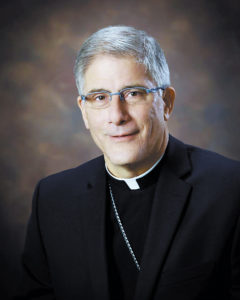
Obispo Joseph Kopacz
Por Obispo Joseph Kopacz
El viernes pasado por la noche regresé de mi peregrinación por la Tierra Santa, patrocinado por los Caballeros y Damas del Santo Sepulcro. Después que las telarañas de las 15 horas de vuelo progresivamente han sido barridas por la bendición de un buen sueño y de encontrarme ya en mi hogar, puedo ver que las lecturas bíblicas del primer domingo de Cuaresma son un puente entre mi experiencia en la Tierra Santa y el comienzo del sagrado tiempo de la cuaresma. El tema del bautismo fue primordial en el primer domingo de Cuaresma de este año, como escuchamos en la primera carta de Pedro, reflexionando sobre la gran inundación en el tiempo de Noé. “Noé y su familia fueron salvados a través del agua. Esto prefigura al bautismo, que los salva ahora. No es una eliminación de la suciedad del cuerpo, sino un llamamiento a Dios para una buena conciencia a través de la resurrección de Jesucristo”.
Inmediatamente antes de que Jesús fuera dirigido hacia el desierto por el Espíritu Santo, en el Evangelio del domingo pasado, fue bautizado por Juan en el Río Jordán y revelado como hijo predilecto de Dios. En el transcurso de 40 días en el desierto, en soledad y comunión con el Padre celestial, pero sin estar protegido de los asaltos de las tentaciones, Jesús fortaleció su identidad como hijo predilecto de Dios. Al salir del desierto, inmediatamente comenzó a caminar a grandes pasos, proclamando el reino de Dios y el llamado a reformar nuestras vidas y a creer en el evangelio, nuestro ritual del Miércoles de Ceniza, sellado por nuestro Amén. Uno de los momentos más intensos de la peregrinación a la Tierra Santa fue nuestra reunión en el Río Jordán. No estamos hablando de un rio del tamaño del Rio Mississippi, sino de una gran corriente de agua que fluye del Mar de Galilea, en el norte, hacia el Mar Muerto en el sur. Sin embargo, tiene un profundo significado para todos los cristianos, como el lugar donde el ministerio público de Jesús brotó del corazón de Dios.
La historia de Noé y el diluvio es una poderosa historia de fe, como sabemos, pero no podemos situar estos eventos en el espacio y en el tiempo. Por otro lado, el Río Jordán es real, el ministerio de Juan el Bautista es histórico, y Jesús es el único a quien Juan preparó el camino. A través de los ojos de la fe y el deseo de renovar nuestro pacto del bautismo en la muerte y resurrección de Jesucristo, nosotros los peregrinos nos paramos a la orilla del Jordán y profesamos nuestra fe. Seguidamente se hizo el Rito de la Aspersión con el agua marrón del río, genuinamente, pero también remilgadamente por la posibilidad de poder tragar algo de esta agua. Alrededor de nosotros, un flujo constante de peregrinos vino a renovar su bautismo, o ser bautizados por primera vez en las aguas fluyentes. Un rápido vistazo alrededor de las pasarelas y las riberas del río reveló la presencia de discípulos de las tradiciones ortodoxas y de las denominaciones evangélicas y bautistas que estaban de pie en el río celebrando la inmersión completa. Estaban en el río mientras estábamos por el río. Una gran diferencia física, pero en cualquiera de los rituales es la fe que tenemos en el Señor Jesús y en su llamada a vivir como sus discípulos lo que está en el corazón de la cuestión. ¿Van a cambiar nuestras vidas cuando sea necesario una vez que el agua se evapora?
Este momento de gracia ocurrió aproximadamente a mitad de la peregrinación que comenzó en Galilea, en el Mar de Tiberias, donde pudimos salir y visitar Nazaret, el lugar de nacimiento de María y el lugar donde Jesús vivió oculto antes de su ministerio público. Capernaúm también fue parte del circuito del norte donde estuvimos, en el sitio de la sinagoga donde Jesús inició su ministerio público formal predicando, enseñando, expulsando demonios, sanando a la suegra de Pedro, y perdonando los pecados del paralítico cuyos amigos lo bajaron por el techo a la casa de Pedro al cruzar la calle de la sinagoga. Todo ello ocurrió después de que Jesús anunció el Reino y la llamada a la penitencia. Los descubrimientos arqueológicos y sitios de excavación de la segunda mitad del siglo XX han autenticado los relatos evangélicos de la sinagoga y la casa de Pedro en Capernaúm.
De vuelta al río. Después de la renovación de nuestra alianza bautismal en el Río Jordán, volvemos nuestra mirada a Jerusalén y a los últimos días de la vida de nuestro Señor que conocemos como el Domingo de Ramos y la Semana Santa, que conducen a la muerte y la resurrección del Señor. Esta segunda mitad de la peregrinación también incluyó visitas a Jericó y Betania, el sitio de la comunidad de los Esenios en Qumran y el Mar Muerto. Solamente las fotos, cientos y cientos de ellas, algunas de las cuales envié por Twitter después de cada uno de los eventos del día, me proporcionarán muchos momentos de reflexión y beneficio espiritual durante la Cuaresma.
Con la Iglesia y en nuestra vida personal, el Señor nos llama a cada uno de nosotros durante esta peregrinación de 40 días a apartarnos del pecado y creer en el Evangelio, para recordar que somos polvo y á polvo hemos de regresar, y que al final hay tres cosas que permanecen, la fe, la esperanza y el amor, y la mayor de todas ellas es el amor. Que nuestra oración intencional de la Cuaresma, el ayuno y la limosna, nos lleven a valorar las cosas que realmente importan en Cristo Jesús, descartando las que no sirven, y sabiendo profundamente que nuestra ciudadanía está en el cielo. Somos los hijos amados de Dios en Jesucristo, y que podamos vivir en los plenos pasos del maestro.

